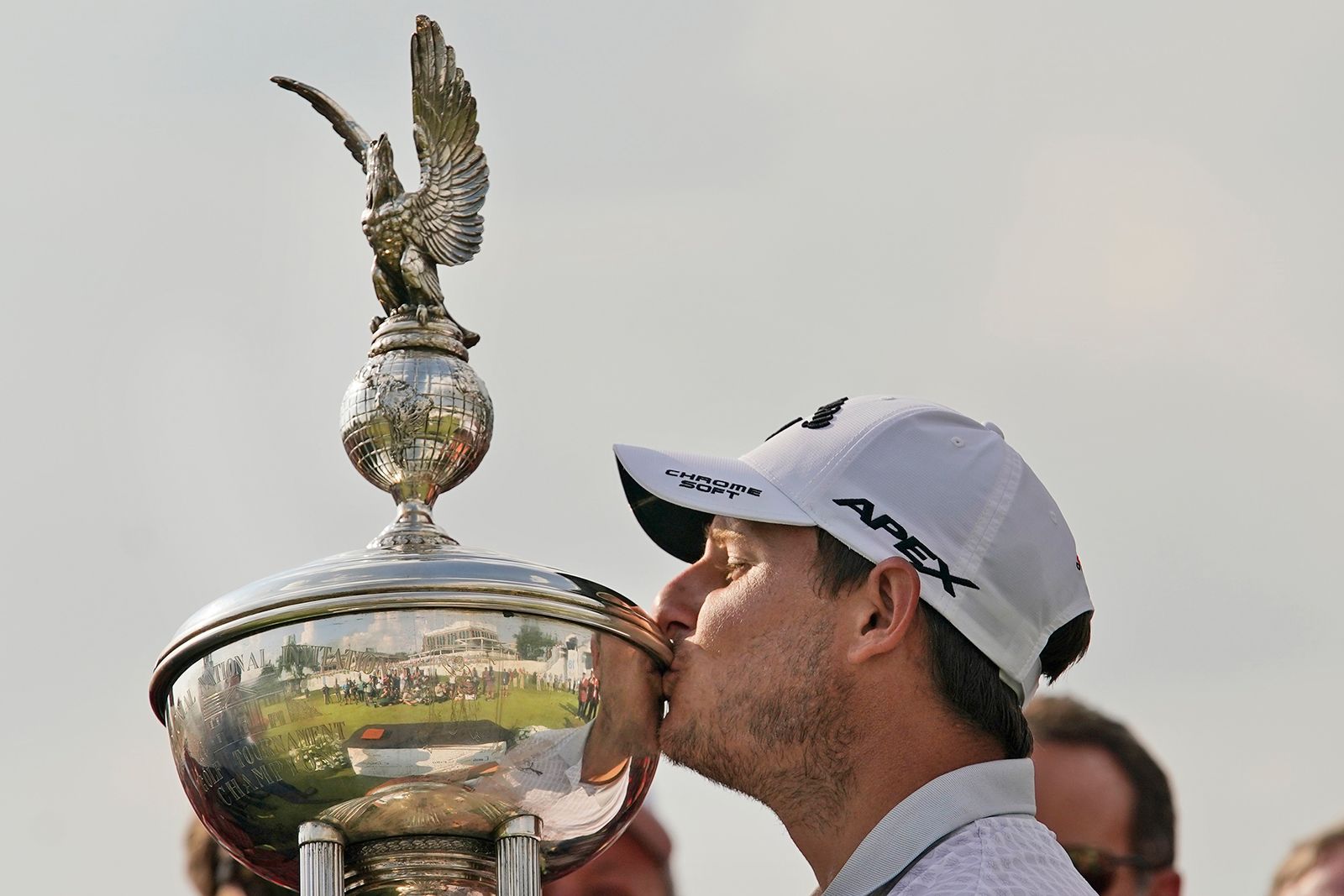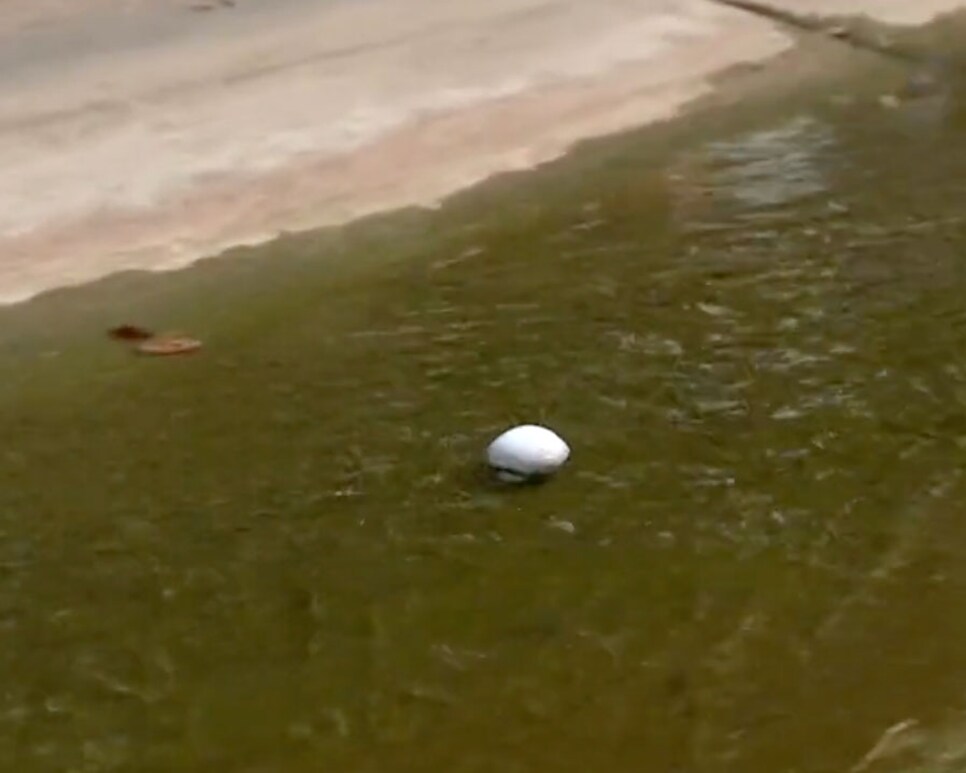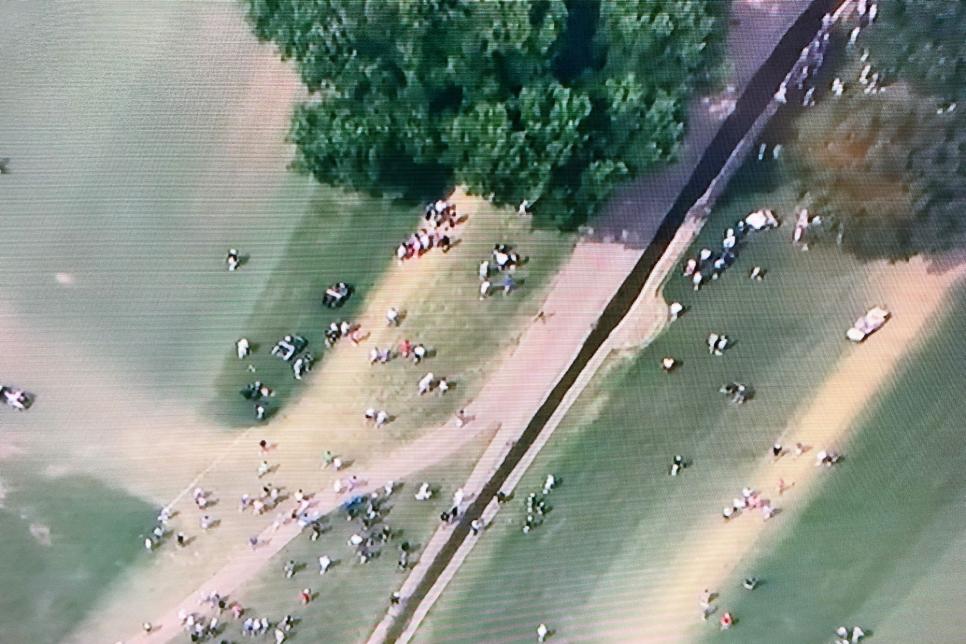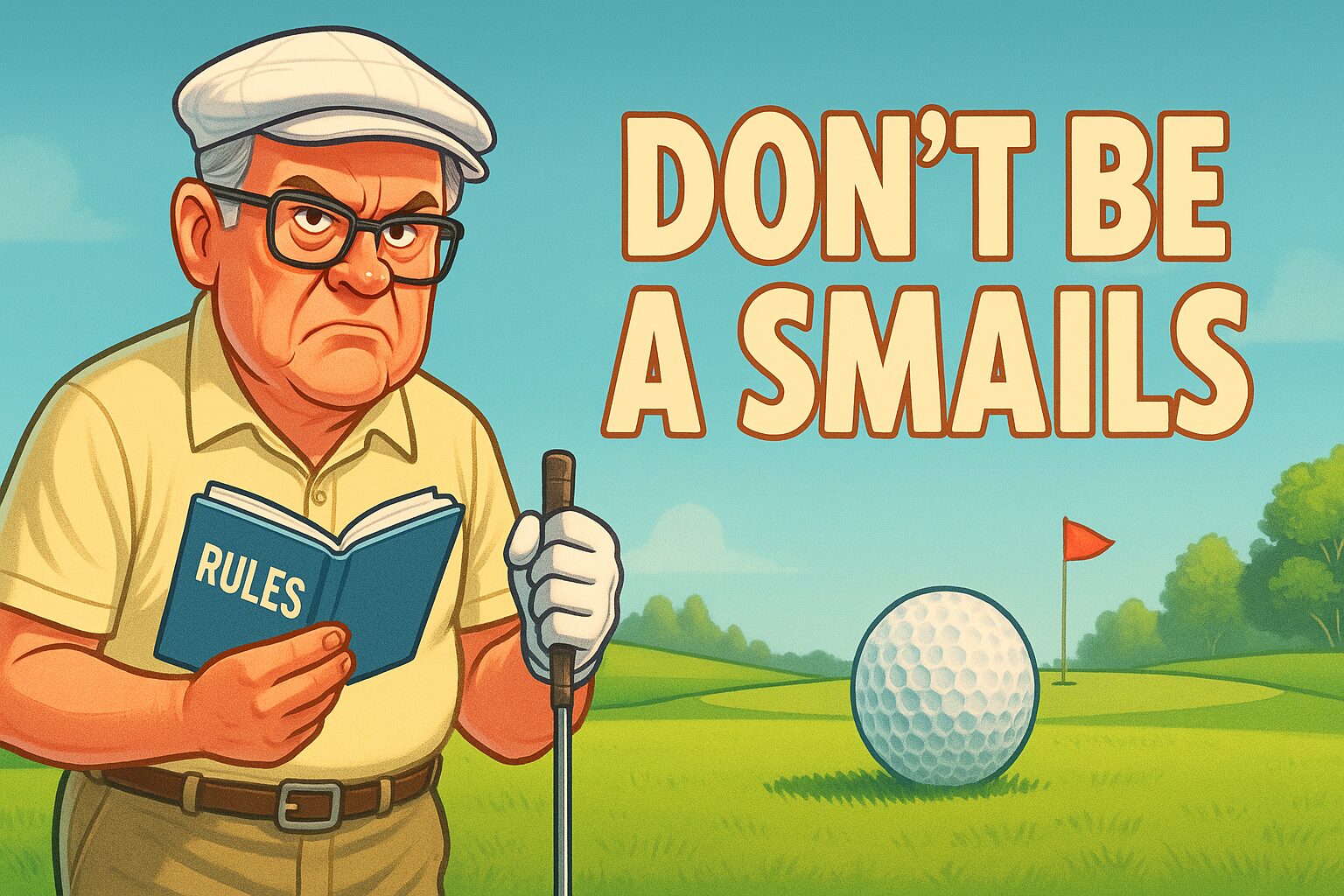Blog
Emiliano Grillo could have hit a moving ball?!?

That and all the other crazy things we learned from his bizarre rules incident over the weekend including cart path drops…

We admit to being guilty from time to time of overusing the terms “bizarre” and “rules incident” in the same sentence. But we’re not entirely sure how to more aptly characterize what happened to Emiliano Grillo on the 72nd hole of the Charles Schwab Challenge than as, well, a “bizarre rules incident.”
It all becomes more, ahem, bizarre thanks to the fact that Grillo overcame the double-bogey 6 he would make on the 72nd hole to win in a playoff anyway, ending a nearly eight-year PGA Tour victory drought when he looked like it was drifting away down that aqueduct along the 18th hole.
Here then is our attempt at explaining what went down and why it was so … again, sorry, bizarre…
The set-up
Grillo started the day at Colonial Country Club in Fort Worth four shots back of Harry Hall and Adam Schenk but made a furious charge, birdieing four of his first seven holes. As Schenk and Hall struggled down the stretch, both searching for their first PGA Tour wins, Grillo took a two-shot lead with another birdie on the par-3 16th. That was his advantage as he stood on the 18th tee at 10 under for the tournament.
All wet off the tee
Despite being ahead by two, Grillo used a driver off the tee, the ball leaking quickly to the right. It eventually found its way into a penalty area to the right of the fairway, in an aqueduct with water about two to three inches deep.

Downstream issues
The aqueduct tilted downhill back toward the tee, so as the ball entered the water, it started following the flow and moving backward. Slowly. Very slowly …

The rules explained
Mark Dusbabek, the PGA Tour rules official working the broadcast, helped explain to Jim Nantz, Trevor Immelman, and the CBS crew what was going on in real-time as he was also listening in to the rules team’s discussions. Dusbabek explained that they had identified where the ball had entered the penalty area (roughly 187 yards away from the hole), which was the likely place Grillo would take a drop and play what would be his third shot with the penalty stroke. However, as the ball continued moving—as we said very slowly—down the aqueduct, there was the potential that Grillo could actually play the ball while it was moving.
Rule 10.1d notes that “A player must not make a stroke at a moving ball.” However, there are a few exceptions also listed. Exception 3 states, “When a ball is moving in temporary water or in water in a penalty area, the player may make a stroke.”
Dusbabek noted the potential for Grillo to hit the moving ball, but did Grillo know he could? Turns out he likely did, since he’d been in this aqueduct before.
“I’ve hit it there,” Grillo said after the round. “I knew, as soon as I saw the ball going right, I was like, ‘This is going to be a very long hole.’ I’ve been through that pain of watching the ball just roll 120 yards back.”

Decision time
As the ball kept moving, however, Dusbabek explained that eventually, Grillo had to make up his mind on how he wanted to proceed. He couldn’t wait forever to see if the ball would stop in a more advantageous spot or not or if he was set to hit it while it was moving. And after roughly seven minutes, Dusbabek even interjected that the committee had decided enough was enough and that Grillo would have to decide to play the ball where it entered the penalty area (or presumably take a stroke and distance penalty and go back to the tee).
“We as a committee have been talking about it but enough time has taken place and he has been given enough time to make a decision here, so we’re going to make him go back to where it last crossed,” Dusbabek said.
Moments later, the ball did stop against a rock, roughly 140 yards or so from where it entered the penalty area.
Third shot off a cart path?!?
The camera eventually showed Grillo taking a penalty drop just outside the aqueduct but the ball rolling back in. He did this twice and then placed the ball on the concrete, which got the curiosity of Immelman.

“Dus, why was he allowed to drop it on the path right there?”
Dusbabek alerted everyone that the red line for the penalty area was right of where he took the drop. So the cement path was not in the penalty area, and is considered an immovable obstruction. Grillo didn’t seem to be phased by it as he showed no hesitation in what was going to happen next.
Grillo played his third shot off the concrete, getting a pretty clean shot off. The ball advanced 146 yards, leaving him 44 yards left to get up and down for a bogey, that would still have given him a one-shot lead. But the fourth shot stopped 19 feet from the hole and he missed the bogey putt.
The rest of the story
To his credit, Grillo didn’t mope around after his stumble, signing for a two-under 68 and waiting to see what would happen to Schenk and Hall as they played the 18th hole. Sure enough, Hall also found water, although the more traditional sort, as he pulled his drive into a small pond left of the fairway. He’d eventually make a bogey to finish tied for third.
Schenk had a chance to win in regulation with a birdie try from 15 feet but just came up short, forcing a playoff. They both replayed the 18th for the first sudden-death hole, Grillo finding the fairway this time. Pars from both sent them to the par-3 16th, where a birdie from Grillo would clinch the victory.
Blog
The Unofficial Rules of Golf: A Gentleman’s Guide to Not Being Judge Smails
The official rulebook is thicker than a dictionary and twice as boring. Let’s talk about the rules that really matter on the course: how to have fun, respect the game, and not be a stick-in-the-mud. Hint: It involves less plaid and more cosmic harmony.

You’ve seen him. I’ve seen him. The guy who quotes the USGA rulebook like it’s scripture. He’ll happily tell you your ball moved a quarter of an inch when you addressed it, costing you a penalty stroke. He’s got a plumb bob for a three-foot putt and the personality of a rake. He is, in spirit, Judge Smails. And let’s be honest, nobody wants to be Judge Smails.
The real game of golf, the one that keeps us coming back, isn’t played by those rules. It’s played by a higher law. An unwritten code of conduct that’s all about flow, friendship, and the pursuit of that one perfect shot. It’s a gentleman’s agreement with the universe.
So, let’s talk about the rules that actually matter.
1. The Cosmic Readjustment (aka The Mulligan). Your first tee shot is a mess. It goes sideways into the woods where the gophers play. The Smails of the world would tell you to take a penalty and hack it out. I say the universe is just getting warmed up. The “breakfast ball” isn’t cheating; it’s a course correction. It’s an agreement among friends that a round of golf shouldn’t be ruined before it even begins. Take another. The Dalai Lama would want you to.
2. The Art of Flow (aka Pace of Play). This isn’t about rushing. Rushing is a fool’s game. This is about flow. It’s about being ready to hit when it’s your turn. It’s about watching your friend’s shot so you can help them find it. It’s about moving with a purpose, not like you’re searching for your car keys in a dark parking lot. Don’t be the anchor that drags the whole group down. See the line, hit the ball, walk on. Nanananana.
3. The Circle of Friendship (aka Gimmes). Is the putt inside the leather? Good enough. Pick it up. Life is too short to watch your buddies sweat over an 18-inch putt for a double bogey. A gimme isn’t just a time-saver; it’s a gesture of goodwill. It says, “I trust you, you trust me, and neither of us needs the anxiety of missing this tiny putt.” It’s good for the karma, and even better for the pace of play.
4. The Final Verdict (aka The 19th Hole). The most important rule is this: no matter what happened out there, you shake hands on the 18th green and settle things over a cold drink at the 19th. The guy who shot an 82 and the guy who shot a 102 are equals in the clubhouse. The stories get better, the putts get longer, and the bad shots fade away. This is where the real game is won.
So, forget about the fine print. Focus on the feeling. Be a good playing partner, enjoy the walk, and don’t be a Smails. You’ll find your score starts to take care of itself.
Did this speak to your soul? Pass it along to your foursome to make sure everyone is on the same page. For more deep thoughts from the fairway, be sure to follow us on social media. It’s the right thing to do.
Blog
When Golf Gadgets Fail: Navigating Common Tech Mishaps on the Golf Course
A Look at What Happens When Modern Golf Gadgets Go Wrong

Imagine this: you’re on the golf course, teeing off on a beautiful, sunny day. With the help of your trusty golf gadget, you’re confident you’ll hit a birdie or even an eagle. But just when you’re about to swing, your gadget malfunctions. Suddenly, your perfect game is thrown into chaos. Welcome to the world of technology fails, where even the most advanced golf devices can sometimes let you down. In this article, we’ll explore some common tech fails and provide some tips on how to handle them.
When Golf Gadgets Let You Down
Modern golf devices, from smart clubs to digital scorecards to GPS-enabled watches, have revolutionized the game. They provide golfers with real-time data, helping them refine their swing, choose the right club, and navigate the course. But what happens when these devices fail?
Unreliable Data
One of the most common golf gadget fails is inaccurate or unreliable data. GPS devices might show the wrong distance to the pin, swing analyzers might give incorrect feedback, and digital scorecards might miscalculate your score. This can be frustrating, especially when you’re relying on these devices to improve your game.
Battery Drain
Another common issue is battery drain. Many golf gadgets require a significant amount of power, and if they’re not properly charged, they can die in the middle of a game. This leaves you without the data you need to make informed decisions on the course.
Technical Glitches and Malfunctions
Sometimes, golf devices just stop working. They might freeze, crash, or refuse to turn on. These technical glitches can be caused by software bugs, hardware issues, or even user error.
Preventing Golf Gadget Fails
While it’s impossible to prevent all golf gadget fails, there are steps you can take to minimize the risk.
Regular Updates
Keeping your devices updated can help prevent software-related issues. Regular updates often include bug fixes and improvements that can enhance the performance of your device.
Proper Charging
To avoid battery-related problems, make sure to fully charge your devices before hitting the course. Some devices also have power-saving modes that can help extend battery life.
Backup Plan
It’s always a good idea to have a backup plan in case your devices fail. This might mean carrying a traditional scorecard or having a basic understanding of how to calculate distances without a GPS.
When Gadgets Go Wrong: The Bottom Line
Golf gadgets are a fantastic tool for any golfer looking to improve their game. However, like all technology, they can sometimes fail. By understanding the common issues and how to prevent them, you can ensure you’re prepared for any tech-related hiccups on the course. After all, golf is about more than just the gadgets—it’s about the experience, the skill, and the love of the game.
Blog
Mastering the Art of Overcoming Choking under Pressure: Strategies for Peak Performance
Learn the skills needed to stay calm under pressure.

Imagine this: you’ve spent countless hours honing your skills, preparing for that big presentation, important meeting, or decisive sports match. But, when the big moment arrives, instead of performing at your best, your mind goes blank, your hands shake, and you flub it. The dreaded phenomenon of ‘choking under pressure’ can strike anyone, from the seasoned professional to the eager amateur. So, how do you overcome this common mental roadblock? In this article, we’ll explore effective strategies to help you conquer the fear of choking and elevate your performance under pressure.
Understanding Choking under Pressure
Before you can overcome choking, it’s crucial to understand what it is. Psychologists define choking as performing below your ability under pressure. This can be due to heightened anxiety, overthinking, or fear of failure. The irony is, the more you care about performing well, the more likely you are to choke.
Why Do We Choke?
Several factors contribute to choking under pressure. Here are a few:
-
- Fear of Negative Evaluation: The fear of being judged negatively by others can cause significant anxiety, leading to poor performance.
- High Stakes: When the stakes are high, and the outcome is important, the pressure can cause you to underperform.
- Overthinking: The tendency to scrutinize every detail in high-pressure situations can divert your focus from the task at hand.
Strategies to Overcome Choking
Now that we understand why we choke, let’s delve into strategies to prevent it:
- Practice Under Pressure: Simulate high-pressure situations during practice to acclimate yourself to the stress.
- Focus on the Process, Not the Outcome: Concentrating on the process helps keep your mind focused and prevents overthinking.
- Use Positive Affirmations: Positive self-talk can boost your confidence and reduce anxiety.
Case Studies: Athletes Overcoming Choking
Many successful athletes have overcome choking to deliver exceptional performances. Take Michael Jordan, for example. He often missed crucial shots early in his career but used these failures to fuel his determination and eventually became renowned for his clutch performances. Similarly, Serena Williams has bounced back from choking in several matches to claim victory, demonstrating her mental toughness.
Choking under pressure is a common phenomenon, but with the right strategies, it can be overcome. By understanding the causes of choking and implementing techniques like practicing under pressure, focusing on the process, and using positive affirmations, you can learn to perform at your best when it counts the most. Remember, it’s not about never feeling pressure; it’s about learning how to thrive within it.
As Michael Jordan said, “I’ve missed more than 9,000 shots in my career. I’ve lost almost 300 games. 26 times, I’ve been trusted to take the game-winning shot and missed. I’ve failed over and over and over again in my life. And that is why I succeed.” So, next time you face a high-pressure situation, think of it as an opportunity to grow, not a threat to be feared.
If you’ve enjoyed this article and want to learn more about mastering your mental game, subscribe to our newsletter for more tips and strategies. Or, if you’re ready to take your mental toughness to the next level, check out our other articles designed to help you conquer pressure and perform at your peak.
-

 Product Review6 years ago
Product Review6 years agoThe Perfect Practice Putting Mat Review by Jason Tenzer
-

 Blog4 years ago
Blog4 years agoLoophole Rule Offers PGA Tour Pros a Mulligan
-

 Blog4 years ago
Blog4 years ago2021 Buyer’s Guide: The Top 10 Value Golf Balls For Distance & Feel
-

 Blog5 years ago
Blog5 years agoGolf Marriage Counselor
-

 Product Review6 years ago
Product Review6 years agoTHE ADJUSTABLE IRONS: WALKING STICKS GOLF CLUBS
-

 Blog6 years ago
Blog6 years ago9 Biggest Chokes Of The Past Decade
-

 Blog4 years ago
Blog4 years agoWhat Your Golf Clubs Say About You
-

 Equipment6 years ago
Equipment6 years agoOHK Sports Interview by Jason Tenzer



















